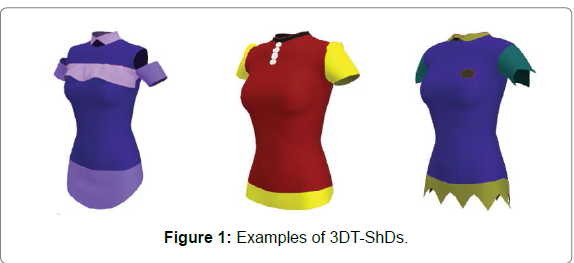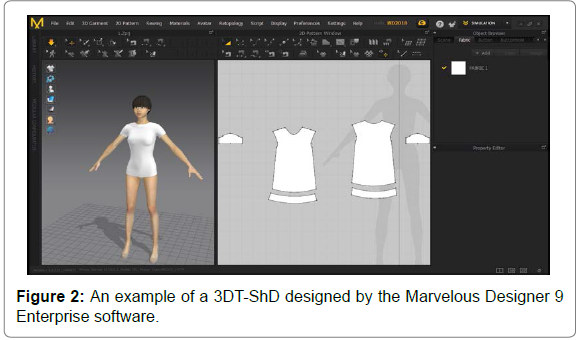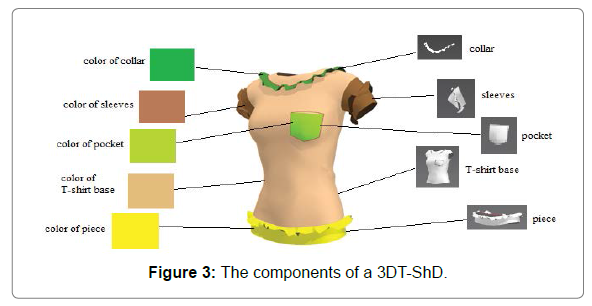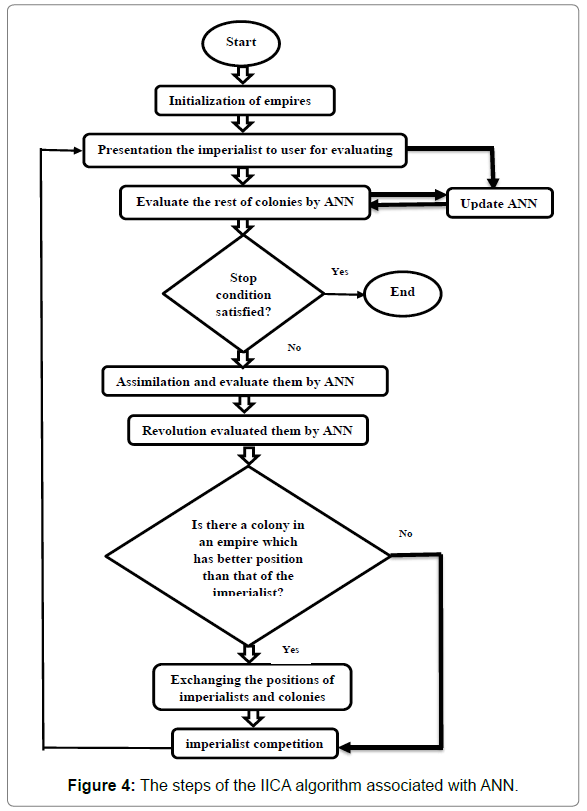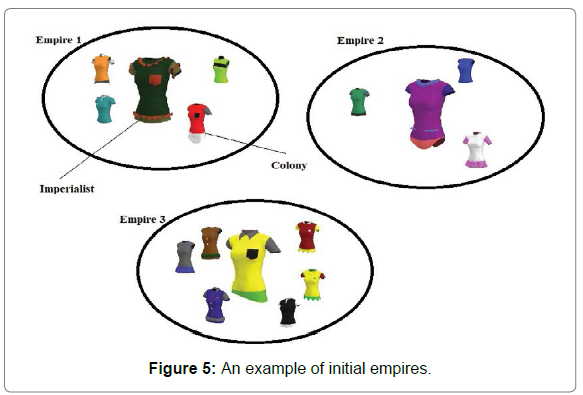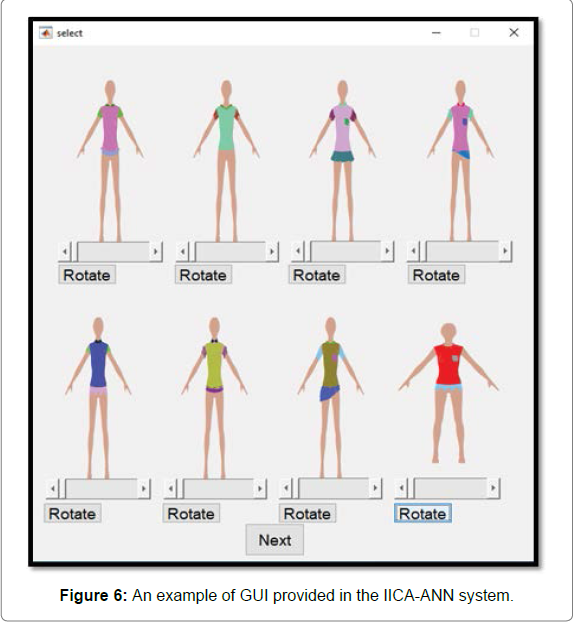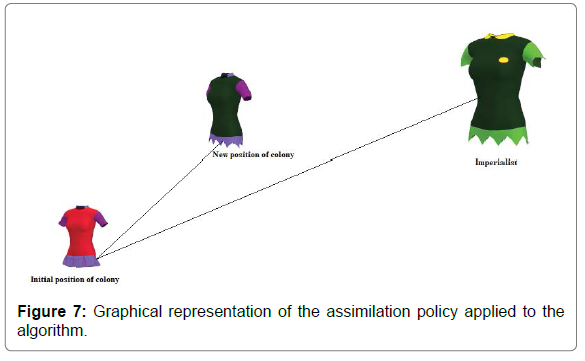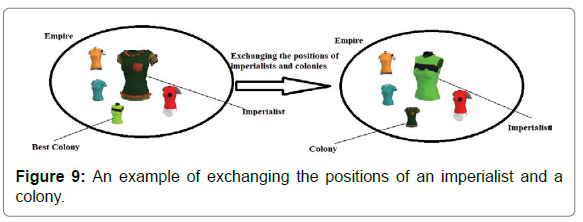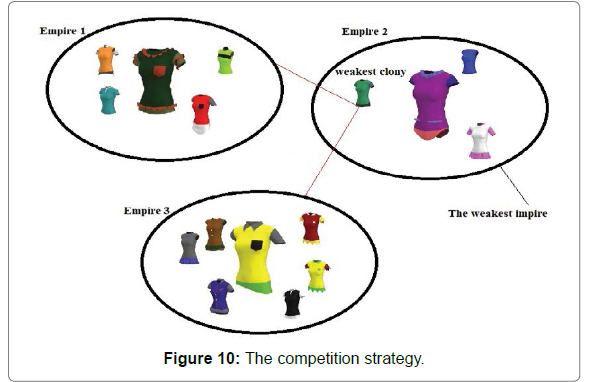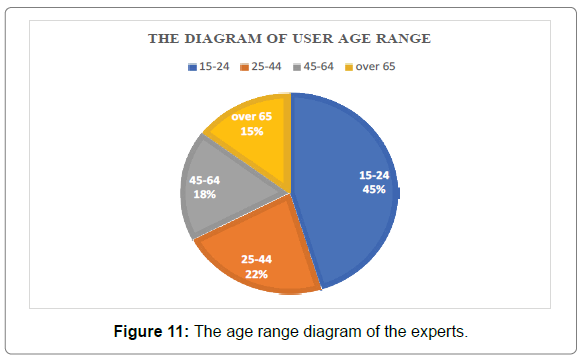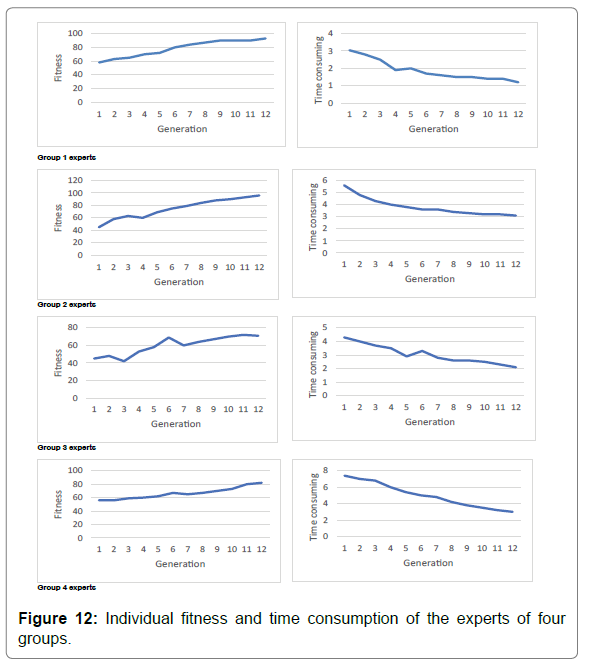Review Article, J Fashion Technol Textile Eng Vol: 9 Issue: 10
Introducing a Novel Fashion Design System Based on Hybrid IICA-ANN
Mansooreh Falah, Fatemeh Maleksabet*
Department of Sewing and Clothing Design, Faculty of Hazrat Roghayeh Branch, Technichal and Vocational University (T V U), Yazd, Iran
- *Corresponding Author:
- Fatemeh Maleksabet
Department of Sewing and Clothing Design, faculty of Hazrat Roghayeh Branch, Technichal and Vocational University (TVU),Yazd ,Iran
E-mail: Maleksabet.f2888@gmail.com
Received Date: October 09, 2021; Accepted Date: October 25, 2021; Published Date: November 01, 2021
Citation: Falah M, Maleksabet F (2021) Introducing a Novel Fashion Design System Based on Hybrid IICA-ANN. J Fashion Technol Textile Eng 9:10. 224.
Copyright: © All articles published in Journal of Fashion Technology & Textile Engineering are the property of SciTechnol, and is protected by copyright laws. Copyright © 2021, SciTechnol, All Rights Reserved.
Abstract
Purpose- The aim of the present study is to propose a novel cloth design system based on hybrid of imperialist competitive algorithmic and artificial neural network (IICA-ANN).
Design/methodology/approach- In this study, a cloth design system based on imperialist competitive algorithmic is proposed. User fatigue is one of the most important problems in interactive systems. Therefore, the artificial neural network is used in this study to mitigate the problem. Women’s T-shirt is used as a 3D database to show the performance of IICA-ANN.
Findings- The statistical results show the efficiency of the system. In addition, the proposed system was compared with a system based on hybrid interactive genetic algorithm and artificial neural network. It proved that proposed system to be satisfactory.
Originality/value- Due to the very rapid developments in the fashion design industry and the different styles and tastes of consumers, manufacturers pay more attention to customer-oriented approaches and try to meet the needs of consumers so that they can offer their products in this industry and increase their profit as well as capabilities. This has led to the emergence of interactive fashion design systems.
Keywords: Fashion design; Artificial Neural Network; Imperialist Competitive Algorithmic; 3D design cloth
Introduction
Nowadays, there are various products available in fashion markets. This variety has made consumers strict when evaluating products and making purchase decisions. In addition, the Internet-based e-commerce space enables customers to search for information, purchase products and receive services through direct contacts with online stores that keep up pace with the diversity of customer needs. Therefore, it is important to design products that accurately match customer needs. Product design is based on participatory design origins in that every person is creative and can represent ideas and dreams. It can possibly be given suitable tools to use even by an ordinary layperson to display his or her creativity. In interactive design systems, consumers participate in design processes by interacting with the computer and expressing their needs. As a result, the final product in an interactive task of designing is close to the user’s preference and provides satisfaction for the user. Recently, interactive designing has developed as a unique method of creating solutions in a wide range of fields including architecture, artwork, circuitry, and fashion. So far, many studies have been done on the use of interactive designs, some of which are presented in Table 1. Clothing design is one of the closest fields of industrial design to human life which has played a decisive role in the achievement of clothing comfort and satisfaction. Also, IGA is one of the most widely used interactive methods in fashion design processes, and extensive research has been done in this area [1-5].
| S.No | Application | Method | Reference |
|---|---|---|---|
| 1 | Sculptured surfaces | Interpolation methods | (Varady, 1982) |
| 2 | Network design in the motor carrier industry | Decomposition strategy | (Powell and Sheffi, 1989) |
| 3 | Fashion design | Interactive genetic algorithms (IGA) | (Lee et al, 2001), (Quiroz et al, 2008) |
| 4 | Roll pass and profile design | Automatic roll groove design | (Kwon and Im, 2002) |
| 5 | Motor vehicle body | Interactive design visualization system | (Lau et al, 2003) |
| 6 | Eyeglass frame model | Interactive industrial design support system | (Yanagisawa and Fukuda, 2004) |
| 7 | Aircraft concept selection | IGA | (Buonanno, 2005) |
| 8 | Electric vehicle | Interactive evolution for industrial design | (Bezitrzis et al, 2007) |
| 9 | Flavoring bottle | Interactive evolutionary design method | (Hummels and Frens, 2008) |
| 10 | Floor planning | IGA | (Banerjee, 2008) |
| 11 | Carpet pattern | IGA | (Zamani, 2009) |
| 12 | Persian rug design | Computational evolutionary approach | (Dalvandi et al, 2010) |
| 13 | Curtain design | IGA | (Xiao et al, 2010) |
| 14 | Product color planning | IGA | (Hsiao et al, 2013) |
| 15 | Cartoon faces | IGA | (Farooq and Siddique, 2014) |
| 16 | Glass industry | Early interactive design | (Segonds et al, 2016) |
| 17 | Car console | Multi-stage IGA | (Dou et al, 2016) |
| 18 | Reconfigurable logistics systems | IGA | (Furmann et al, 2017) |
| 19 | Storage unit | Virtual reality | (Azizi et al, 2019) |
| 20 | Music player UI | IGA via eye tracking | (Cheng and Dey, 2019) |
| 21 | Pattern design | IGAپ | (Zhang et al, 2020) |
| 22 | Electric bicycle | IGA via interval hesitation time | (Wang and Zhou, 2020) |
| 23 | Ceramic disk patterns | IGA | (Cai, 2020) |
| 24 | Jewelry design | IGA | (Kielarova and Pradujphongphet, 2020) |
Table 1: Some researches about interactive designs.
In this study, an interactive fashion design system is proposed to push products toward the preference of users by presenting several 3D models of clothing to them. The novelty of this study is the use of the interactive imperialist competitive algorithm (IICA) in the fashion design process. Also, the proposed system provides a fitness function with ANN for individuals other than the users to make their evaluation [6-8]. In this research, women’s T-shirt is used as a 3D database to show the performance of IICA-ANN. The proposed system is also applicable to more complicated fashion products, such as trousers, blouses, dresses and jackets. To evaluate the efficiency of the system, the results are compared with the IGA-based system of fashion design [9-11].
Methods
Genetic Algorithm (GA)
GA is an adaptive heuristic search algorithm that is based on the evolutionary ideas of natural selection and genetics. Indeed, it is an intelligent random search algorithm to solve optimization problems. The algorithm starts with the production of a large population of possible solutions (chromosomes). Initially, they are randomly generated and are, thus, of very low fitness. Each chromosome is evaluated and given a fitness score [12]. The algorithm proceeds by generating a new population of chromosomes through selecting the best of the previous generation’s chromosomes, recombining them in a crossover manner and then making small random adjustments so as to induce mutation in them. Ideally, the properties of the chromosomes in the parent generation which provide higher fitness are passed down to the offspring chromosomes [13,14].
Imperialistic competitive algorithm (ICA)
ICA is one of the evolutionary algorithms inspired by humans and their societies. The algorithm provides the initial set of possible solutions that are called ‘countries’. These countries gradually improve and eventually provide appropriate answers to optimization problems. Then, the colonial competition algorithm, with its specific process described in Section 3, gradually improves these initial solutions (countries) and eventually provides appropriate solutions to the optimization problems (optimal countries). The foundations of this algorithm are Assimilation Policy, Imperialistic Competition, and Revolution [15]. By simulating the social, economic and political evolution of countries and by mathematically modeling parts of the process, the algorithm presents solutions in a systematic manner so as to cope with complex optimization problems. In fact, this algorithm serves to optimize solutions in the form of countries and seeks to improve these solutions over and over again until it eventually achieves an optimal solution.
Interactive algorithms
In interactive evolutionary algorithms, man preference is considered as a fitness value when the fitness function cannot be explicitly defined. Therefore, there is an interactive relationship between man and computer, which slightly solves the inability of the evolutionary algorithm in various fields, such as art and designing. The advantage of evolutionary algorithms is that there is no need for people to know the details of the job; they only need to evaluate the output. They evaluate a collection of designs presented in the population and then a fitness value is assigned based on subjective criteria [16]. IGA is one of the interactive evolutionary algorithms based on population. It has been used in many studies conducted on clothing design. IICA is another interactive algorithm in this field, which is introduced in this study and described in Section 3.
Artificial Neural Network (ANN)
ANNs are computational methods for machine learning, knowledge demonstration, and applied knowledge to maximize the output response of complex systems. The basic idea behind these networks is partly inspired by the way the biological nervous system works to process data for learning and knowledge creation. A key element of this idea is the creation of new structures for the information-processing system. Beyond interactive evolutionary algorithms, an ANN provides answers by using heuristics that are similar to the human brain [17].
Database Description
T-shirt is a type of clothing used to cover the upper body. Usually, t-shirts do not have buttons and collars but have short sleeves. They used to serve mainly as underwear, but are now often used alone and without any other clothes over or under them. T-shirts are popularly worn around the world, which is partly due to their rather low price and easy wear. Basically, they can be worn with most garments, and, because of the comfort they provide, most people sort them out with pants. In this study, the components of 3D T-shirt designs (3DT-ShDs) make up a database. A few examples of 3DT-ShDs are presented in Figure 1.
Preparing the initial data
The database was divided into the T-shirt component and the color data. The 3DT-ShD components were designed by the Marvelous Designer 9 Enterprise software. An example of a 3DTShD is shown in Figure 2. The 3D T-shirts were each divided into 10 components, such as T-shirt base, sleeves, collar, pocket and a piece below the T-shirt base. For each component, different designs were taken into consideration. The components of a 3DT-ShD are shown in Figure 3.
Hybrid IICA-ANN system
The present study utilizes IICA and ANN to promote fashion designs, increase the productivity of fashion products, and create confidence in mass producers and purchasers, the steps of which are presented in Figure 4.
Initialization of empires
Most evolutionary algorithms operate on a population of solutions. Initially, a set of random solutions is required. Therefore, in this study, the components of 3DT-ShDs were set out to create a database [18]. The initial population containing 500 3DT-ShDs was generated randomly. As the first step, an arbitrary initial population was selected. Some of the best elements of the population were chosen as imperialists. The rest of the population was considered as colonies. An example of initial empires is given in Figure 5.
Presentation of imperialists to users for evaluation
After the classification of the original population into empires, the imperialist of each empire was shown to the user for evaluation. An example of GUI provided in this study is shown in Figure 6.
Evaluation of the rest of colonies by ANN
ANN is a technique used to reduce user fatigue. In order to apply the technique in this system, it was necessary to train it. Therefore, a set of 3DT-ShDs and their fitness levels were provided to the ANN to take the initial steps. For an ANN model, the 10: HN: 1 ANN structure was used. HN is the optimal number of hidden nodes. Also, 3DT-ShDs formed the input of the model, and fitness value was considered to be the output obtained. The data related to the sample were trained in 10 hidden nodes and process elements for the scaled conjugate gradient (SCG) and Levenberg–Marquardt (LM) versions of the multi-layer, feed-forward, and back-propagation algorithms. Seventy data items (70%) were randomly selected from a 100 in the sample data and used for neural network training. Fifteen samples (15%) were also used for validation and 15 others (15%) for testing [19].
Assimilation
The countries of the imperialist begin to improve the condition of their colonies to improve the conditions of the empire. Thus, the clothing designs of the imperialist apply assimilation policies to bring the clothing designs of the colonies to their own conditions as desirable targets. In line with these policies, the countries in the colony somehow move toward taking the position of transfer to the imperialist and, thus, come to a new position. In addition to this movement, a slight angular deviation is added to the position of motion [20]. A graphical representation of the assimilation policy applied to this algorithm is provided on a sagittal plane in Figure 7.
Revolution
The outbreak of a revolution often causes sudden changes in the social and political characteristics of a country. In this algorithm, a revolution is modeled by the random moving of a colony to a new random position. An example of this revolution is shown in Figure 8.
Exchanging the positions of imperialists and colonies
As the colonies move toward the imperialist position, some of them may be in a better position than the imperialist. In this case, the imperialist state and the colonial state replace each other, and the algorithm continues with the colonial state in a new position. It is now the new imperialist state that begins to apply the policy of assimilation to its colonies. An example of exchanging the positions of an imperialist and a colony is shown in Figure 9.
Imperialist competition
The power of an empire is defined as the power of an imperialist state plus a percentage of the total power of its colonies. Any empire that cannot increase its power and loses its competitiveness will be eliminated during imperialist competition. This deletion is gradual [21]. It means that, over time, weak empires lose their colonies but stronger ones seize more colonies and increase their power. This competition strategy is shown in Figure 10.
Results and Discussion
In this study, a graphical interface is presented with the ICA and ANN algorithms as well as the MATLAB graphical user interface, and the results are compared with other user interfaces. These interfaces include systems based on IGA and its corresponding systems as well as methods of optimizing the process and reducing user fatigue. In order to show the effectiveness and superiority of the method presented in this study over previous research works, 150 users of apparel designs who had expertise in design matters were randomly invited to participate in the survey to get their desired optimal 3DTShDs. Since age is a parameter affecting one’s preference for the style, design and model of clothes, the users were divided into four groups according to this parameter. The range of their age is diagramed in Figure 11.
The statistical results addressed the optimal 3DT-ShDs and the average of the highest rates of fitness provided by the groups of users for the design of the most repetitive and time-consuming parts, as shown in Table 2. The goal was to achieve 3DT-ShDs that had the most harmony and conformity with their corresponding age groups. The maximum of individual fitness and the average of time consumption of four groups in each generation are reported in Figure 12. The evolutionary procedure of preparing 3DT-ShDs, shown in Figure 12, keeps pulling the created generations closer together, especially in characteristics or ideas. The evaluation of the optimal fitness values in the evolution process of the 3DT-ShDs shows an increase of evolution with the increase of evolutionary iterations [22]. Therefore, as the evaluation of the optimization process in the generations suggests, the system converges in eight generations, the final optimal 3DT-ShDs are close to the users’ favorite designs, and the system performance is satisfactory for them. Of course, there are fluctuations in the maximum amount of fitness for each generation, which can be due to user fatigue and age-related characteristics. The overall evaluation, however, points to an upward trend. The results generally show that the proposed system, using IICA and ANN, increases user satisfaction and can help designers find favorite 3DTShDs for users [23].
| Expert | The first group | The second group | The third group | The fourth group |
|---|---|---|---|---|
| Optimal T-shirt design |
|
 |
 |
 |
| Fitness | 87 | 85 | 64 | 67 |
| time consumption (s) | 1.58 | 3.37 | 2.56 | 4.16 |
Table 2: Statistical results.
In addition, as shown in Figure 12, the time consumed for evaluation gradually decreases in each generation. With an increase in the number of generations, the evaluation time taken by all the expert groups had a decreasing trend. The difference of the expert groups in terms of age definitely had significant impact on their selection and preference characteristics. The system proposed in this study is based on the IICA approach in the field of fashion design. It allows the user to evaluate individuals, and there is a possibility of user fatigue. Therefore, a fitness function is formed with ANN to evaluate individuals beside the user in the proposed system [24-26].
To calculate the performance of the IICA-ANN algorithm, the results were compared with a system of fashion design based on the traditional interactive genetic algorithm (IGA-T) and a system based on the interactive genetic algorithm plus ANN (IGA-ANN). These three systems were compared from the viewpoints of the number of evaluated generations, the number of individuals evaluated by the user, and the number of reminding populations evaluated using ANN for total individuals evaluating. The contrast indicators were recorded for the users, as shown in Table 3. Also, the average values (Avg.) and the variance scores (Var.) were calculated for the three mentioned viewpoints in all the three algorithms. The comparative results are given in Table 4. According to the table, the number of the IICAANN generations and the number of the individuals evaluated by the user are the lowest. This proves that the proposed method, compared to previous ones, can significantly reduce user fatigue (Table 4).
| Algorithm | Contrast indicator | 1 2 3 4 5 . . . 147 148 149 150 |
|---|---|---|
| IICA-ANN | Number of the evaluated generations Number of the individuals evaluated by the user Number of the individuals evaluated using ANN |
8 7 7 8 7 . . . 8 7 7 9 64 56 56 64 56 . . . 64 56 64 72 736 644 644 736 644 . . . 736 644 644 828 |
| IGA-ANN | Number of the evaluated generations Number of the individuals evaluated by the user Number of the individuals evaluated using ANN |
9 8 9 8 10 . . . 8 9 8 8 72 64 72 64 80 . . . 64 72 64 64 828 736 828 736 920 . . . 736 828 736 736 |
| IGA-T | Number of the evaluated generations Number of the individuals evaluated by the user Number of the individuals evaluated using ANN |
26 31 24 29 28 . . . 29 28 28 28 208 248 292 232 224 . . . 232 208 224 224 0 0 0 0 0 . . . 0 0 0 0 |
Table 3: Contrast indicators.
| Algorithm | Number of the evaluated generations | Number of the individuals evaluated by the user | Number of the individuals evaluated using ANN | |||
|---|---|---|---|---|---|---|
| Avg. | Var. | Avg. | Var. | Avg. | Var. | |
| IGA-T | 26.54 | 3.21 | 242.24 | 162.31 | 0 | 0 |
| IGA-ANN | 8.6 | 4.93 | 64.06 | 24.88 | 842.21 | 302.43 |
| IICA-ANN | 7.02 | 2.14 | 52.7 | 19.87 | 898.74 | 258.56 |
Table 4: Comparison of algorithms in terms of performance.
Conclusion
In this study, an interactive fashion design system is presented based on the imperialist competitive algorithm. The results show that the behavior of users toward this system and their respect for it when choosing favorite 3DT-ShDs gradually take a certain direction and change from vague to transparent. Therefore, this system can help clothing designers recognize the user’s preferred styles, shorten the process of designing and producing 3DT-ShDs, and thus increase user satisfaction. A neural network is also used in the system. According to the existing database and the information obtained from the user, the network is trained and helps the user find the optimal 3DTShDs quickly, which keeps the user from fatigue. To determine the efficiency of this system, it is compared with the IGA-T and IGAANN algorithms.
References
- Azizi A, Yazdi P G, Hashemipour M (2019) Interactive design of storage unit utilizing virtual reality and ergonomic framework for production optimization in manufacturing industry. Int J Interact Des Manuf 13: 373-381.
- Banerjee A, Quiroz J C, Louis S J (2008) A model of creative design using collaborative interactive genetic algorithms. In Design Computing Cognition 8: 397-416.
- Bezirtzis B G, Lewis M, Christeson C (2007) Interactive evolution for industrial design. In Proceedings of the 6th ACM SIGCHI conference on Creativity & Cognition: 183-192.
- Buonanno M A (2005) A method for aircraft concept exploration using multicriteria interactive genetic algorithms. Georgia Institute of Technology, USA.
- Cai H (2020) User Preference Adaptive Fitness of Interactive Genetic Algorithm Based Ceramic Disk Pattern Generation Method. IEEE Access 8:95978-95986.
- Cheng S, Dey A K (2019) I see, you design: user interface intelligent design system with eye tracking and interactive genetic algorithm. CCF Trans Pervasive Comput Interact 1: 224-236.
- Dalvandi A, Behbahani P A, DiPaola S (2010) Exploring Persian rug design using a computational evolutionary approach. Electronic Visualisation and the Arts: 121-128.
- Dou R, Zong C, Nan G (2016) Multi-stage interactive genetic algorithm for collaborative product customization. Knowl Based Syst 92: 43-54.
- Farooq H, Siddique M T (2014) A comparative study on user interfaces of interactive genetic algorithm. Procedia Comput Sci 32: 45-52.
- Furmann R, Furmannova B, Więcek D (2017) Interactive design of reconfigurable logistics systems. Procedia Eng 192: 207-212.
- Hsiao S W, Hsu C F, Tang K W (2013) A consultation and simulation system for product color planning based on interactive genetic algorithms. Color Res Appl 38: 375-390.
- Hummels C, Frens J (2008) Designing for the unknown: A design process for the future generation of highly interactive systems and products. In DS 46: Proceedings of E&PDE 2008, the 10th International Conference on Engineering and Product Design Education, Barcelona, Spain: 204-209.
- Kielarova S W, Pradujphongphet P (2020) Collaborative Product Design for Product Customization: An Industrial Case of Fashion Product. In International Conference on Cooperative Design, Visualization and Engineering: 37-46.
- Kwon H C, Im Y T (2002) Interactive computer-aided-design system for roll pass and profile design in bar rolling. J Mater Process Technol 123: 399-405.
- Lau H Y K, Mak K L, Lu M T H (2003) A virtual design platform for interactive product design and visualization. J Mater Process Technol 139: 402-407
- Lee J H, Kim H S, Cho S B (2001) Accelerating evolution by direct manipulation for interactive fashion design. In Proceedings Fourth International Conference on Computational Intelligence and Multimedia Applications: 343-347.
- Mozafary V, Payvandy P, Bidoki S M, Bagherzadeh R (2013) Predicting the influence of seam design on formability and strength of nonwoven structures using artificial neural network. Fibers Polym 14: 1535-1540.
- Powell W B, Sheffi Y (1989) Or practice design and implementation of an interactive optimization system for network design in the motor carrier industry. Oper Res 37: 12-29.
- Quiroz J C, Banerjee A, Louis S J (2008) IGAP: interactive genetic algorithm peer to peer. In Proceedings of the 10th annual conference on Genetic and evolutionary computation: 1719-1720.
- Segonds F, Cohen G, Véron P, Peyceré J (2016) PLM and early stages collaboration in interactive design, a case study in the glass industry. Int J Interact Des 10: 95-104.
- Várady T (1982) An experimental system for interactive design and manufacture of sculptured surfaces. Comput Indus 3: 125-135.
- Wang, T., & Zhou, M. (2020). A method for product form design of integrating interactive genetic algorithm with the interval hesitation time and user satisfaction. Int J Ind Ergon 76, 1-15.
- Xiao-yan S, Chen J, Ma X, Gong D (2010) Grid-based knowledge-guided interactive genetic algorithm and its application to curtain design. In 2010 Second World congress on nature and biologically inspired computing: 395-400.
- Yanagisawa H, Fukuda S (2004) Development of Interactive Industrial Design Support System Considering Customer's Evaluation (Shape Design of Eyeglass Frame). JSME int j Ser C Mech syst mach elem Manuf 47: 762-769.
- Zamani F, Amani-Tehran M, Latifi M (2009) Interactive genetic algorithm-aided generation of carpet pattern. J Text Inst 100: 556-564.
- Zhang N, Pan R, Wang L, Wu Y, Gao W (2020) Pattern design and optimization of yarn-dyed plaid fabric using modified interactive genetic algorithm. J Text Inst 111: 1652-1661.
 Spanish
Spanish  Chinese
Chinese  Russian
Russian  German
German  French
French  Japanese
Japanese  Portuguese
Portuguese  Hindi
Hindi 